My leadership story
Published on
The second part of module one was to deliver a presentation focussing on my own leadership journey.
Published on
The second part of module one was to deliver a presentation focussing on my own leadership journey.
Published on
Question:
Tell a story that encapsulates your leadership approach, including leadership values and style. Your presentation should demonstrate the application of leadership framework(s).
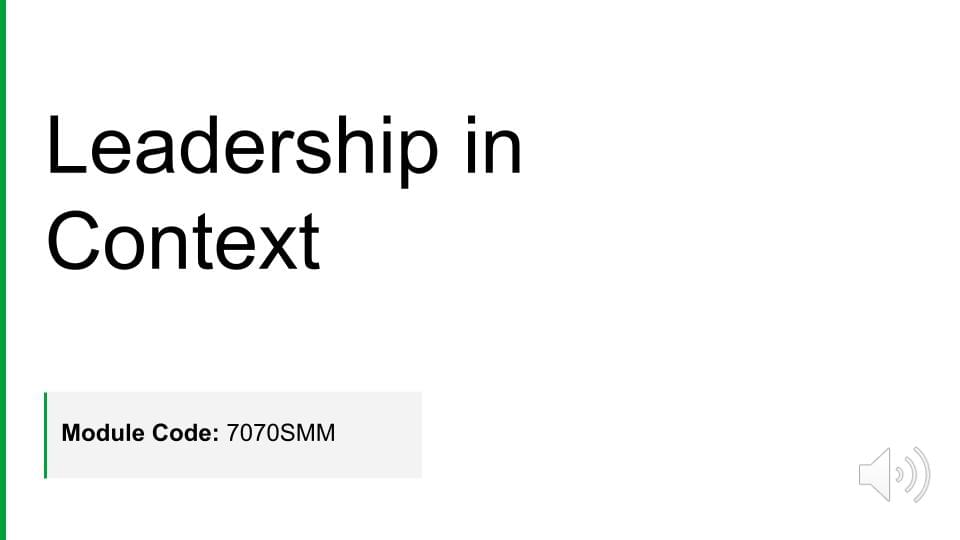
I’m going to talk briefly about why I moved into a leadership role and my thoughts on what leadership is. Then I’m going to explain a specific incident and how that has changed my approach to leadership. I’ll end with reflections and plans to enhance my leadership practice.
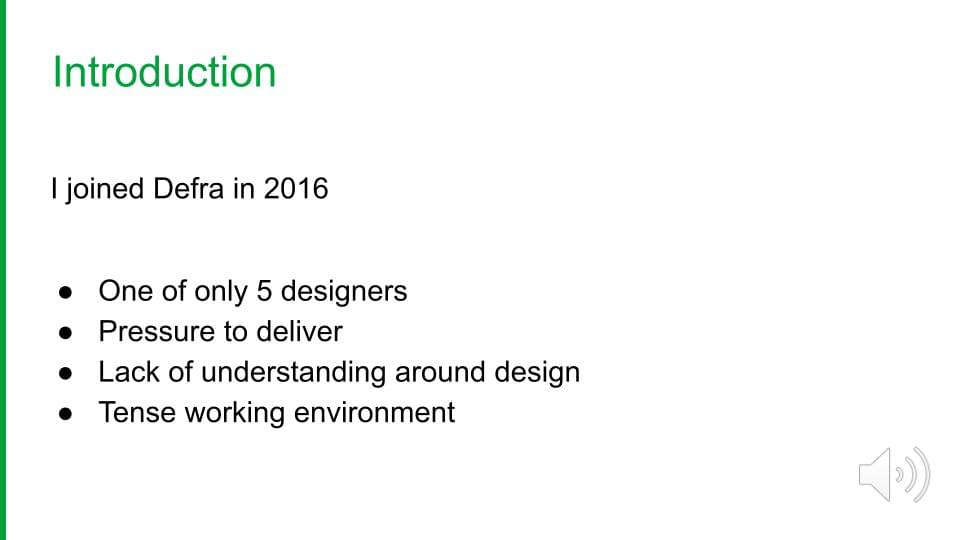
I joined Defra in 2016 working as one of only 5 designers in the organisation. The team I joined was under a lot of pressure to deliver and had also recently failed a Government digital service assessment.
Part of my role was to help the team pass a re-assessment, the team though were not used to working with a designer and had limited understanding of the role of designers in Government. This created quite a tense and at times unpleasant working environment.
Personaly it was a challenging and upsetting introduction to design in Government, something I didn't want myself or anyone else to experience again.
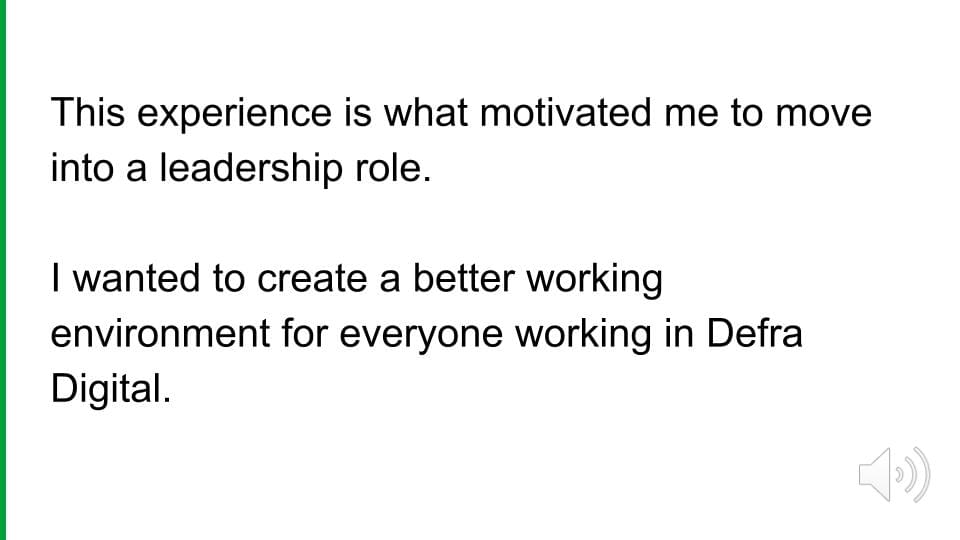
My experience in that team is what motivated me to move into a leadership role. I wanted to create a better working environment for designers and for everyone else working in Digital teams in Defra. I also wanted to establish and grow the understanding of design across the organisation.
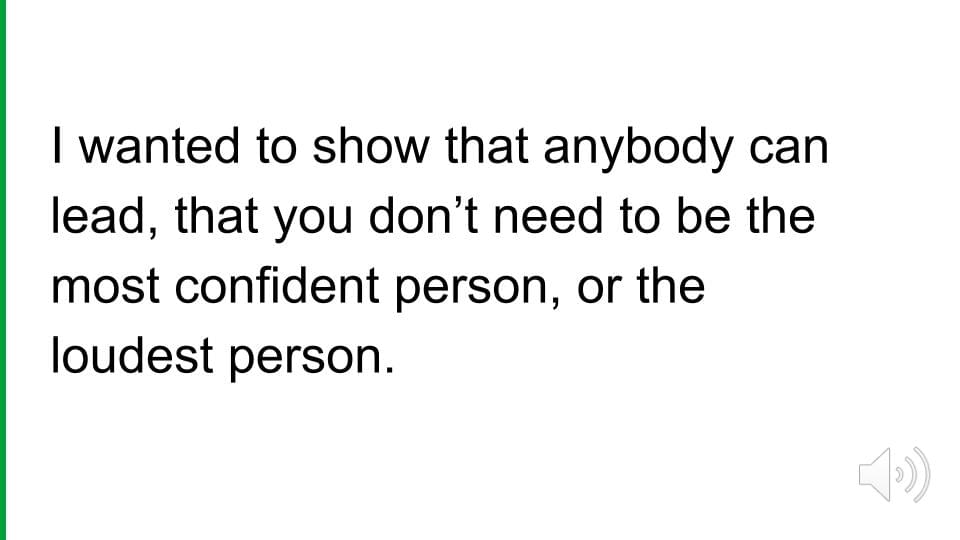
I also really wanted to show that anybody could be a leader or take on a leadership role. I wanted to demonstrate that you don't need to be the most confident person, or the loudest person in the room. And that leadership takes many forms so quieter or less confident people can still lead team’s successfully.
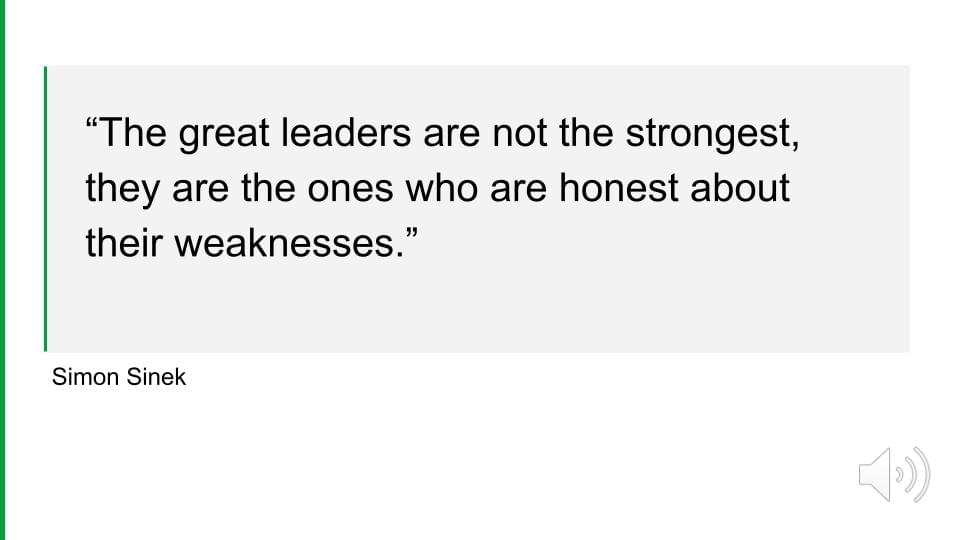
The way I felt is summarised nicely in this quote from Simon Sinek, who sais…
“Leaders are not the strongest, they are the ones who are honest about their weaknesses.”
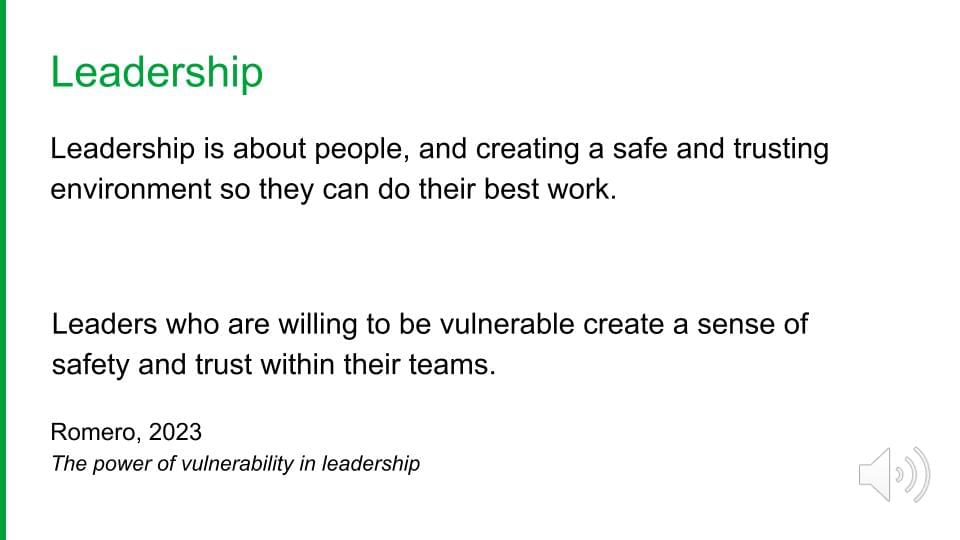
To me, leadership is all about people and creating a safe and trusting environment so that everyone in the team can do their best work. Luis Romero described leaders who successfully build that trust as being willing to be vulnerable, sharing their weaknesses and struggles to create a sense of safety in their teams.
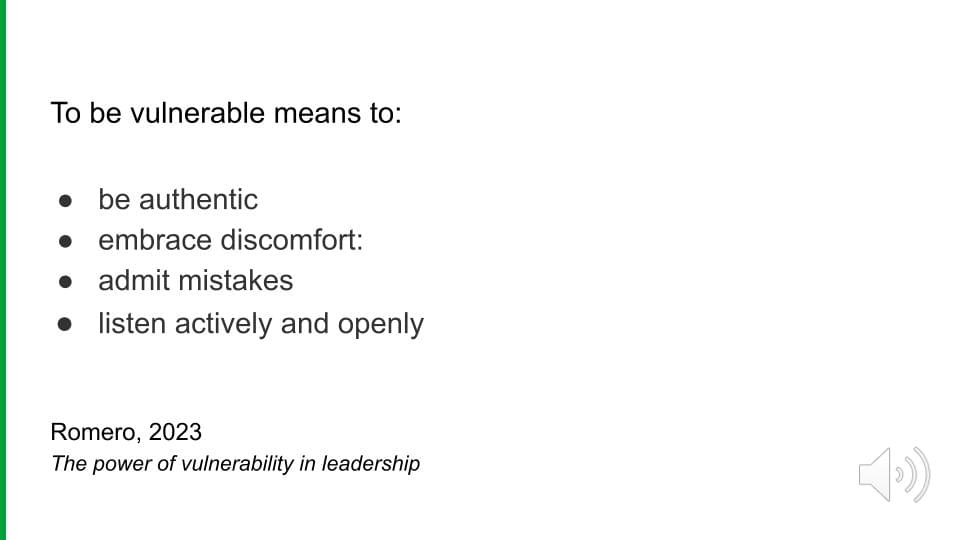
They also describe what it means to be vulnerable as..
Working in this way creates collacollaberotive, creative, and successful teams.
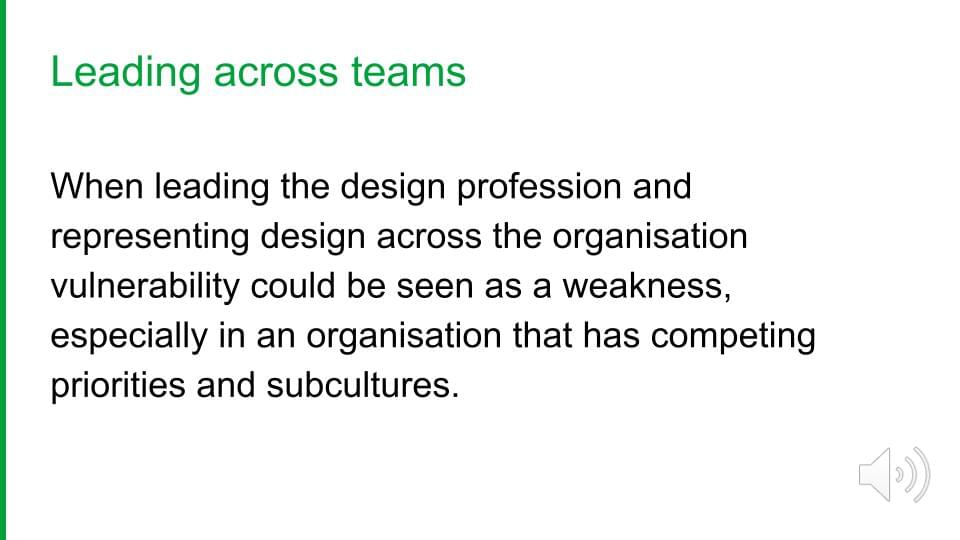
I think this approach to leadership was successful within the design team, where I scaled the team from less than 10 people to more than 60 people over a 3-year period. In that time we collaboratively created a progression framework, wrote design standards, introduced junior roles, created training plans, and sourced external training partners, making sure we continually invested in and developed our in-house team.
However when leading the design profession and representing design across the organisation vulnerability could be seen as a weakness, especially in an organisation that has competing priorities and subcultures.
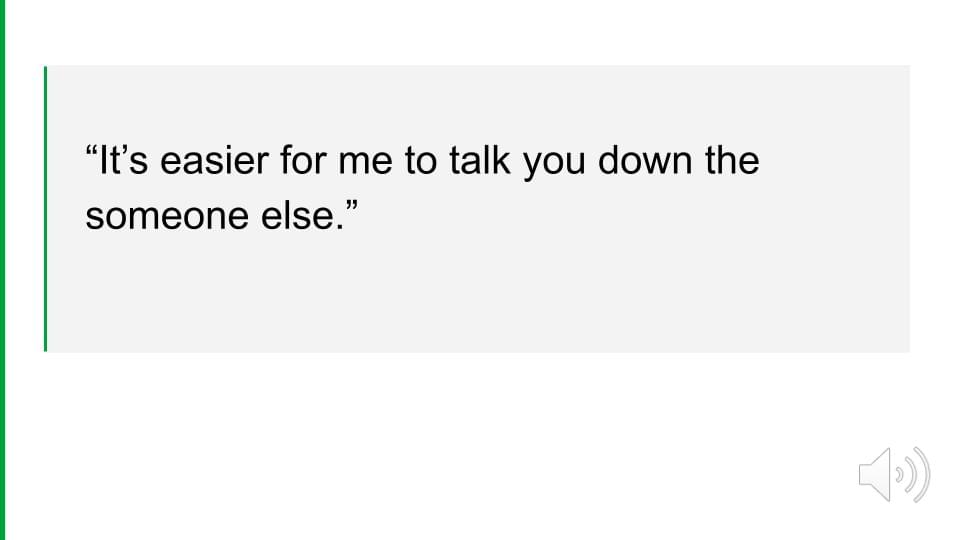
This was really brought home to me when someone put a meeting in my diary specifically to try to change a decision I had made. I had suggested taking a user centered approach to a project, and using a service designer to carry out an exploration phase. When this was challenged he believed it would be easier to talk me down then anybody else in the group.
“it’s easier for me to talk you down the someone else.”
As well as being a difficult thing to hear from an experienced colleague this also reminded me of other comments I’d received over the years things like..
“How will someone like you lead a workshop”
And the repeating feedback I get around needing to be more confident and needing to be more assertive in meetings.
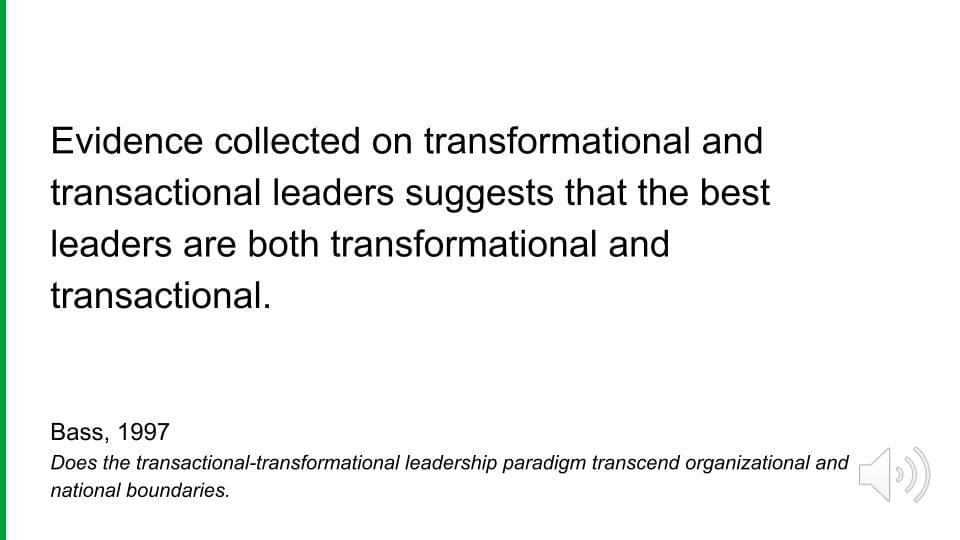
After that meeting I made the decision to try to hide more of myself, or at least be less open about anything that had the potential to be viewed as a weakness.
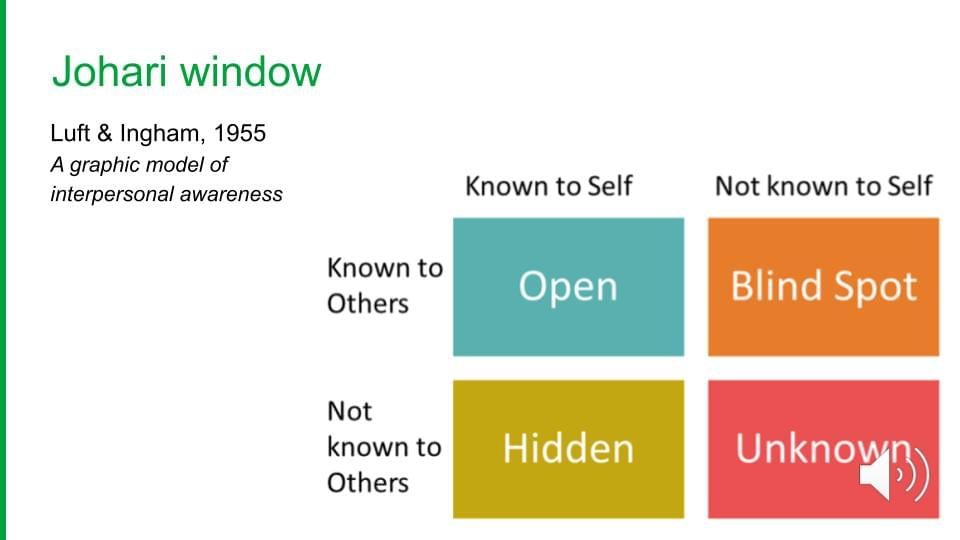
This slide shows an image of the Johari window a model designed by Luft and Harrington in 1955 to help people understand their relationship with themselves and others. With the design team I was able to expand the open area building strong relationships and creating trust. I also reduced the hidden area by disclosing personal vulnerabilities, creating a safe environment for open communication.
After this meeting my focus moved towards closing that open area, I started to share only relevant information or information specific to the project.
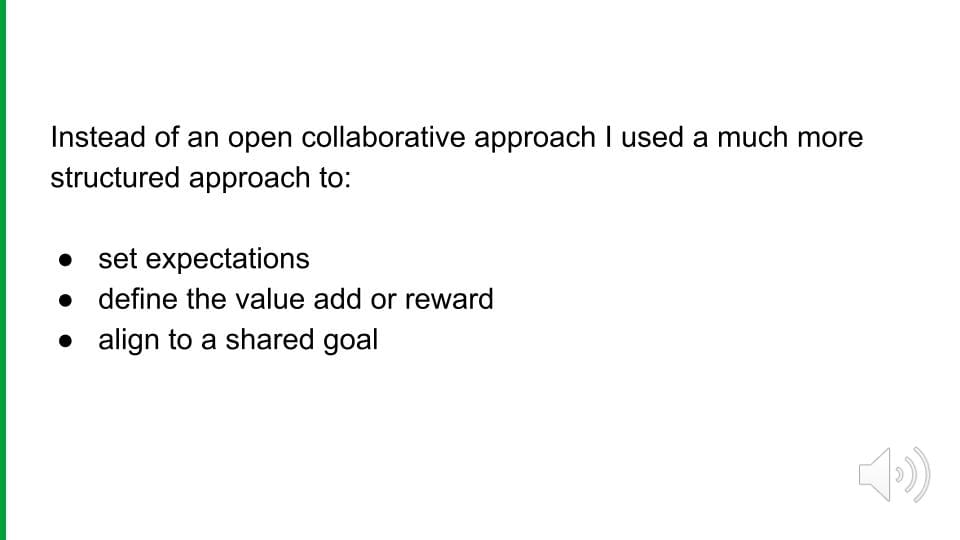
I also moved away from my usual collaborative approach I went back to a follow up meeting with a clear agenda where I set out expectations for the project, clearly defined the value add or reward of working in a user centred way, and related design work to shared goals of reducing costs and saving time
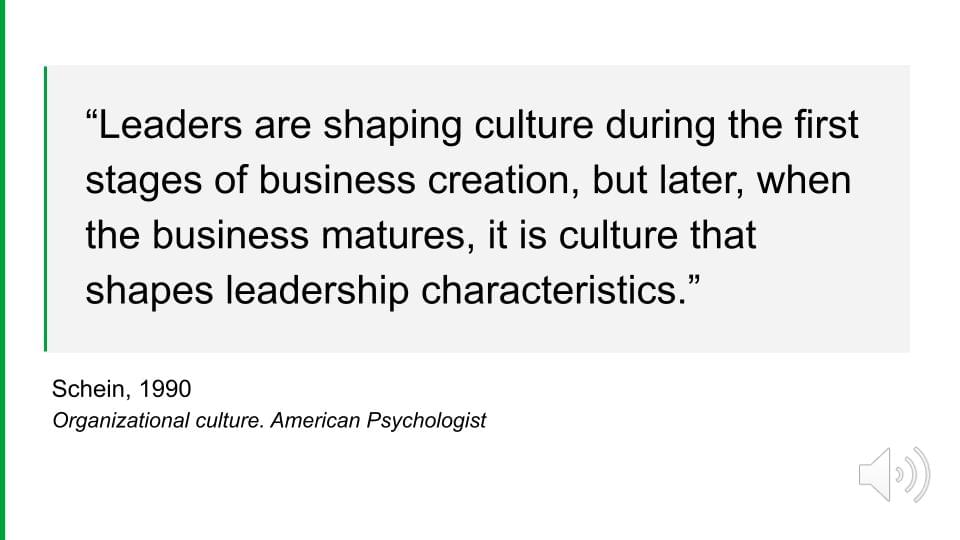
My decision to change my approach has strong links with Schein’s theory on the relationship between leadership styles and the maturity of an organisation. They believed that
“Leaders are shaping culture during the first stages of business creation, but later, when the business matures, it is culture that shapes leadership characteristics.”
As the leader of the design team I was able to set the culture. But in the wider organisation where processes and structures were already in place my leadership style was directed by Defra’s existing culture.
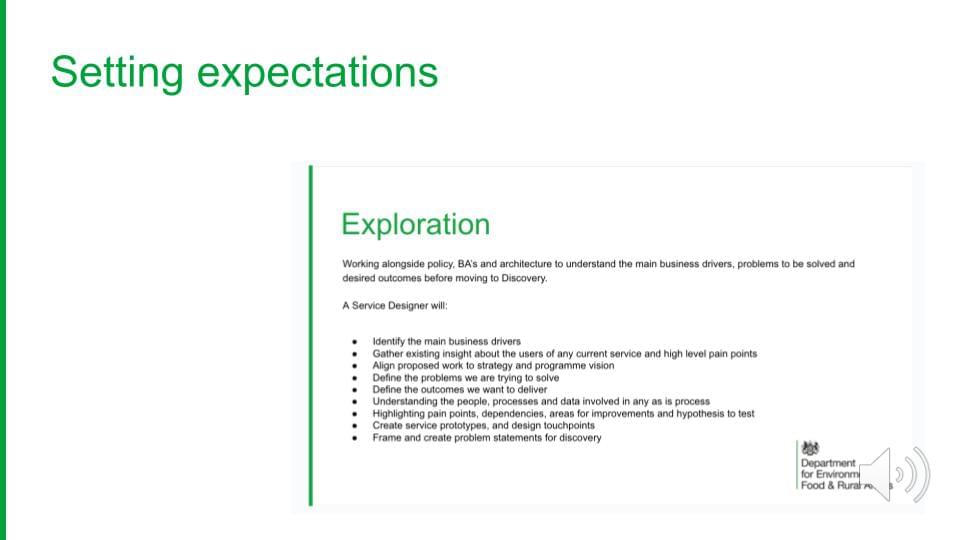
To set clear expectations I created a detailed breakdown of what a designer would do on the project. Things like:
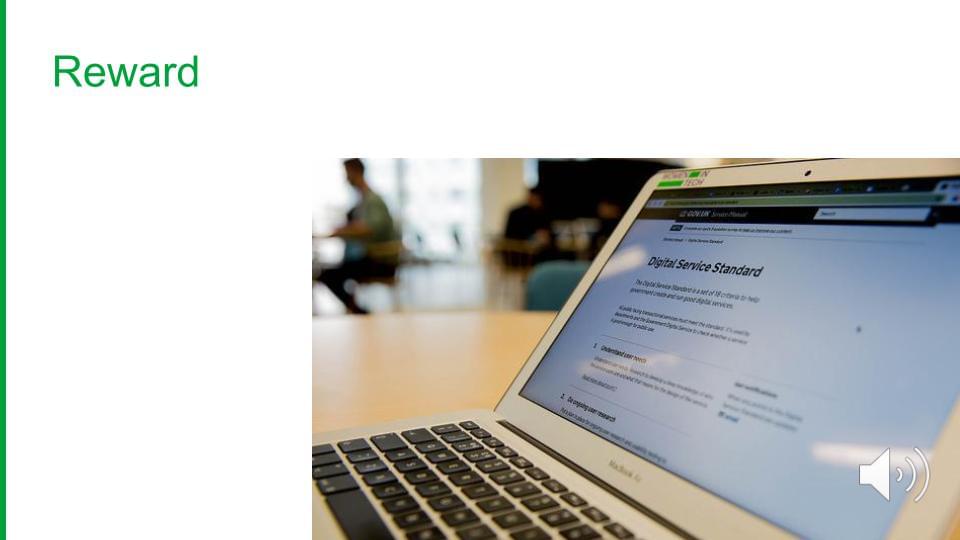
To create a sense of reward or value exchange I outlined where and how the service designer would help the team to meet certain points in the service standard. For example..
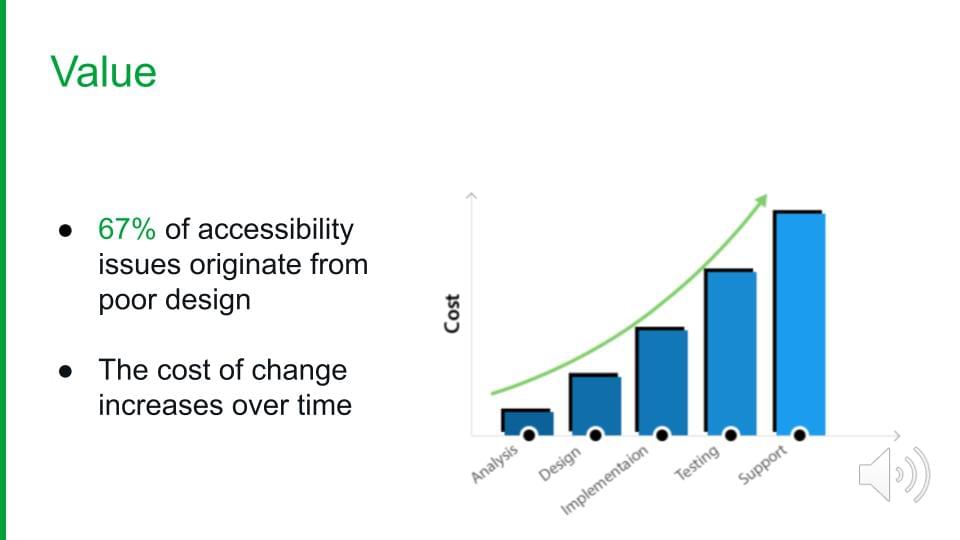
To demonstrate shared value I aligned the work of the service designer to a common goal of reducing cost. I did this by highlighting the savings in both money and time when we make things that work first time for our users.
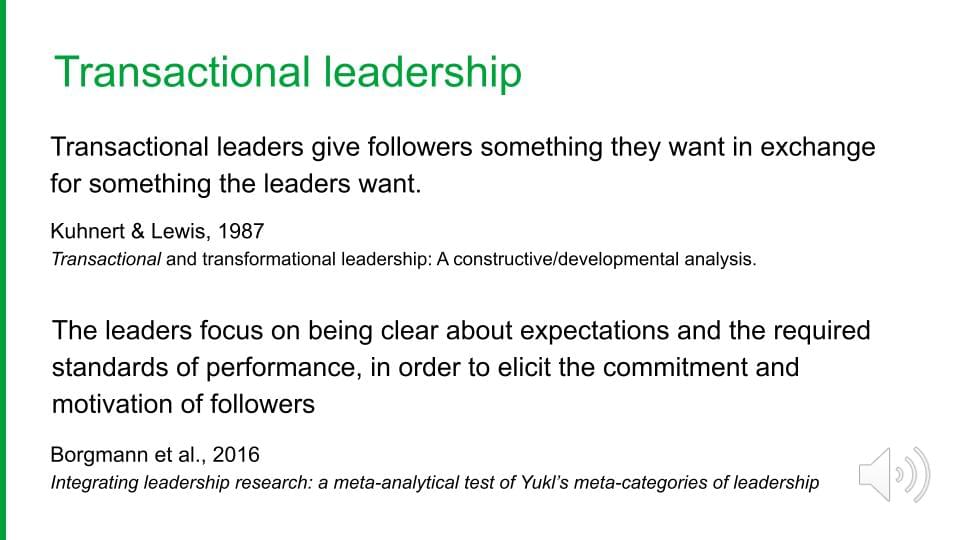
This new approach is more aligned to a transactional leadership style. Transactional leadership is explained by Kuhnert and Lewis as giving followers something they want in exchange for something the leader wants.
Borgmann, Rowold and Bormann also describe transactional leadership as setting out clear expectations and the required standards of performance, in order to gain the commitment and motivation of followers
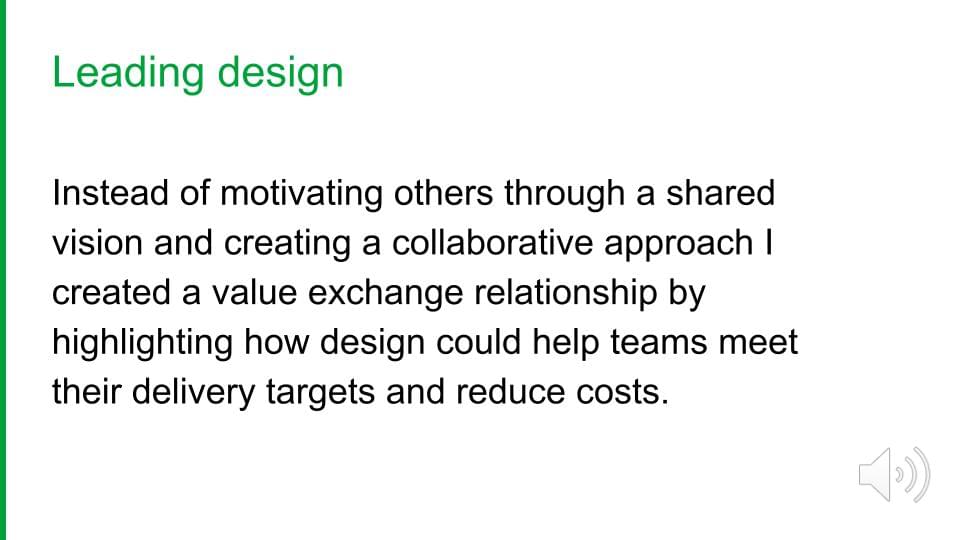
Instead of motivating others through a shared vision and creating a collaborative approach I instead created a value exchange relationship by highlighting how design could help team meet their delivery targets and reduce costs.
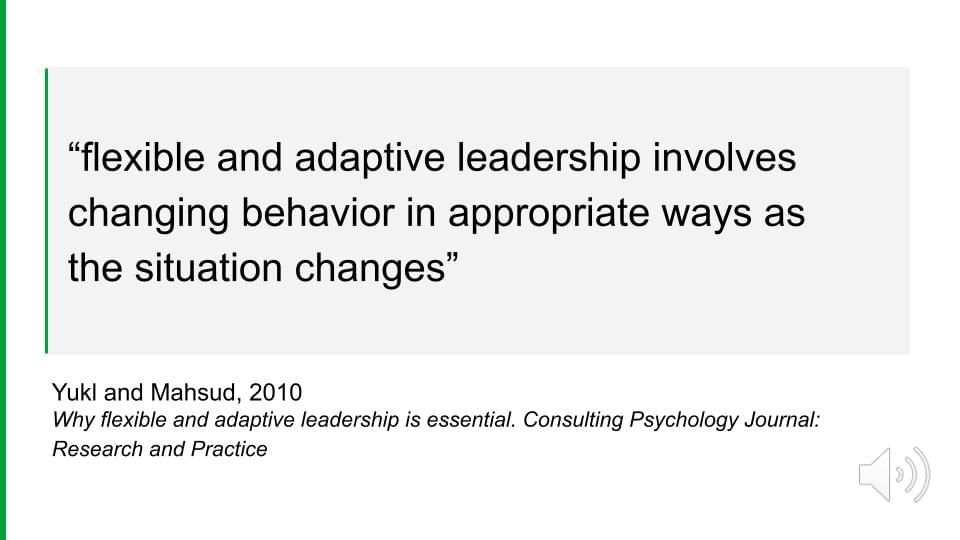
The conclusion I drew form all of this was that to lead successfully in a large organisation I needed to change the way I behaved. This is summed up nicely by Yukl and Mahsud who wrote..
“flexible and adaptive leadership involves changing behavior in appropriate ways as the situation changes”.
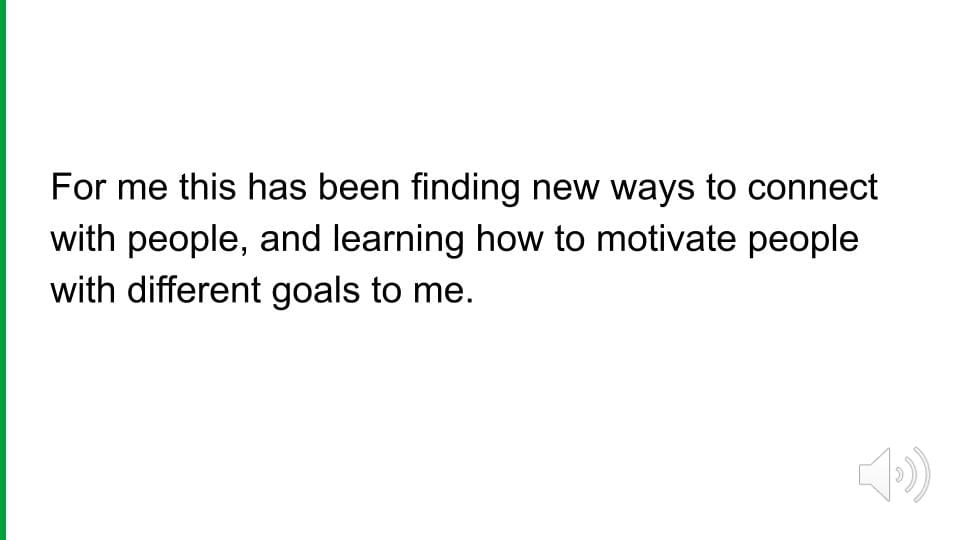
For me this has been finding new ways to connect with people, and learning how to motivate people with different motivations and goals to me.
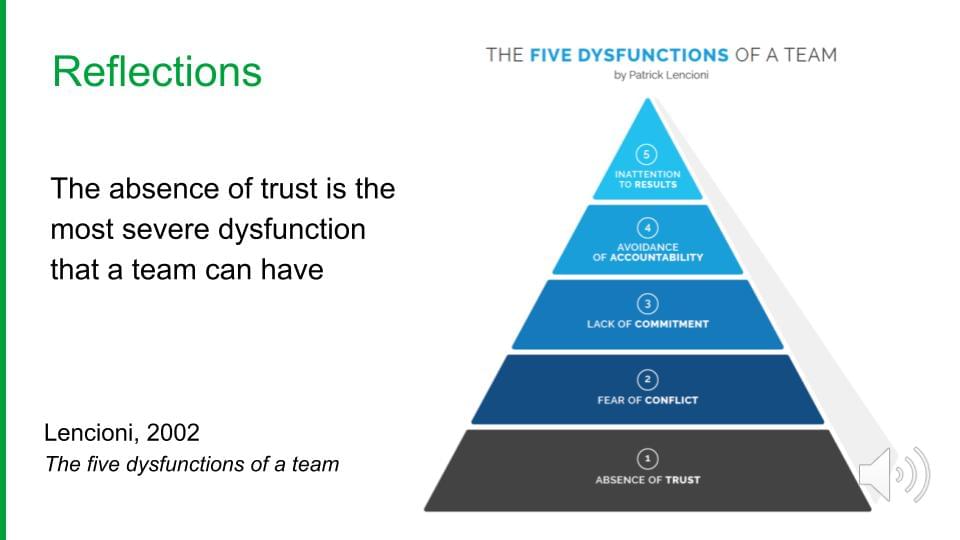
Although the new approach was successful in the sense that the project was set up the way I wanted it to be. The more direct approach meant there was less alignment and therefore less trust between myself and the team. As Lencioni says an absence of trust is the most severe dysfunction that a team can have. Without trust, productive work and growth are almost impossible.
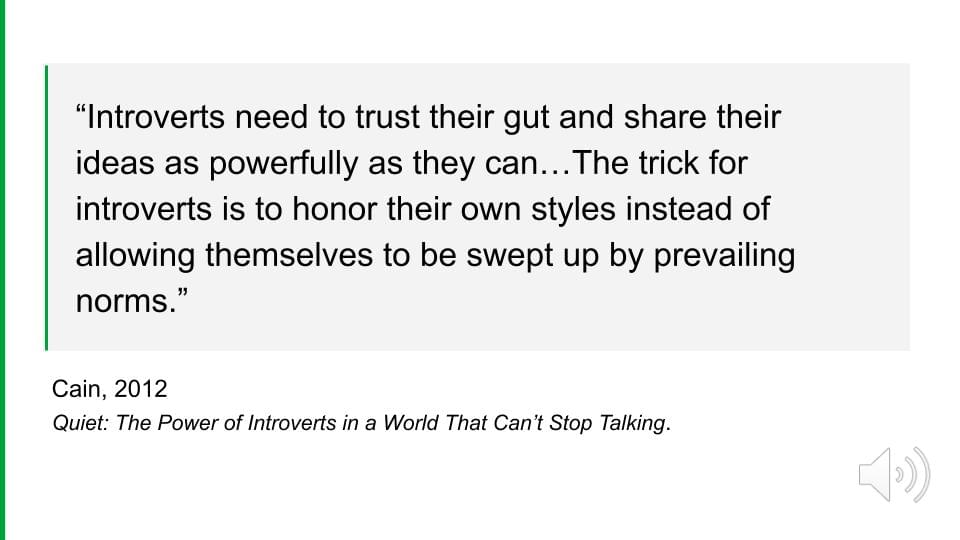
What I need to do is make sure that as I adapt I still make space to build relationships and trust with the people I work with. I also need to find ways to continue to honor my own style, the danger as I adapt to the existing culture is that I might lose sight of my reasons for getting into a leadership role in the first place. This is captured nicely in this quote by Susan Cain..
“Introverts need to trust their gut and share their ideas as powerfully as they can…The trick for introverts is to honor their own styles instead of allowing themselves to be swept up by prevailing norms.”
Borgmann, L., Rowold, J., & Bormann, K. C. (2016). Integrating leadership research: A meta-analytical test of Yukl's meta-categories of leadership. Personnel Review, 45(6), 1340-1366. https://doi.org/10.1108/PR-07-2014-0145
Bass, B. (1997). Does the transactional-transformational leadership paradigm transcend organizational and national boundaries? American Psychologist, 52(2), 130–139.
Cain, S. (2012). Quiet: The Power of Introverts in a World That Can't Stop Talking. Crown Publishing Group.
Kuhnert, K. W., & Lewis, P. (1987). Transactional and transformational leadership: A constructive/developmental analysis. The Academy of Management Review, 12(4), 648-657. https://doi.org/10.2307/258070
Lencioni, P. (2002). The five dysfunctions of a team: A leadership fable. Jossey-Bass.
Luft, J., & Ingham, H. (1955). The Johari window, a graphic model of interpersonal awareness. In Proceedings of the Western Training Laboratory in Group Development. Los Angeles: UCLA.
Romero, L. (2023, March 8). The Power of Vulnerability in Leadership: Experts Say Authenticity and Honesty Can Move People and Achieve Results. Forbes. Retrieved from https://www.forbes.com/sites/luisromero/2023/03/08/the-power-of-vulnerability-in-leadership-experts-say-authenticity-and-honesty-can-move-people-and-achieve-results
Schein, E. (1990). Organizational culture. American Psychologist, 45, 109–119.
Sinek, S. (2011). Start with why: How great leaders inspire everyone to take action. Penguin Books.
Yukl, G., & Mahsud, R. (2010). Why flexible and adaptive leadership is essential. American Psychologist, 65(4), 301–317. https://doi.org/10.1037/a0019835